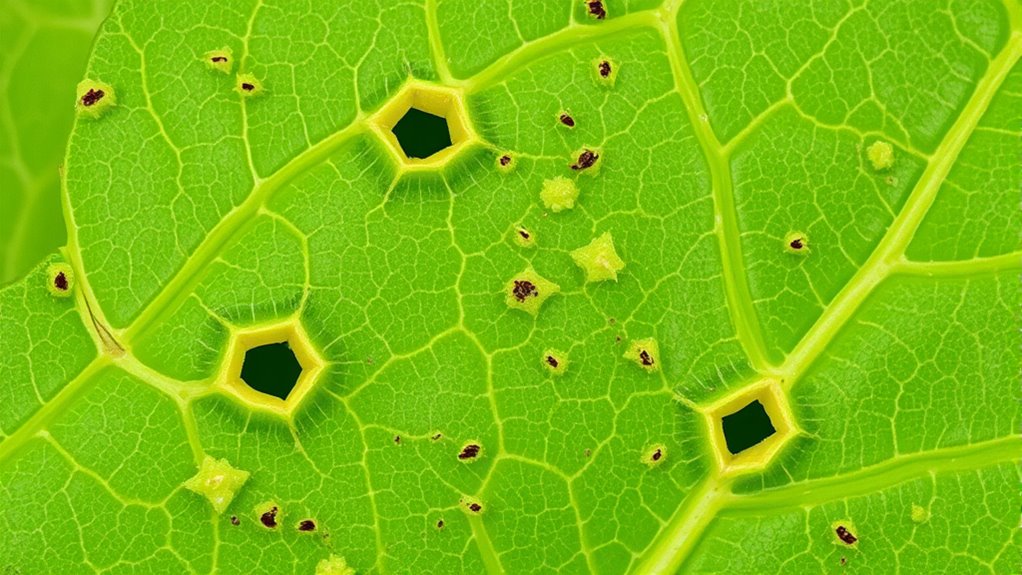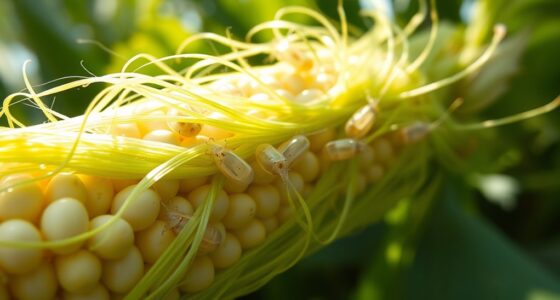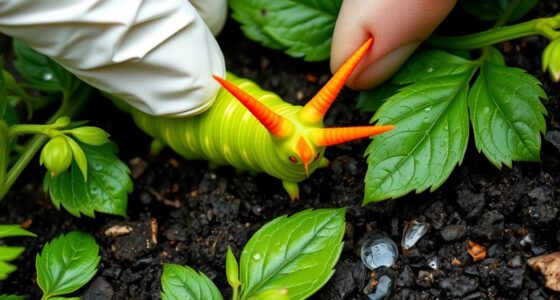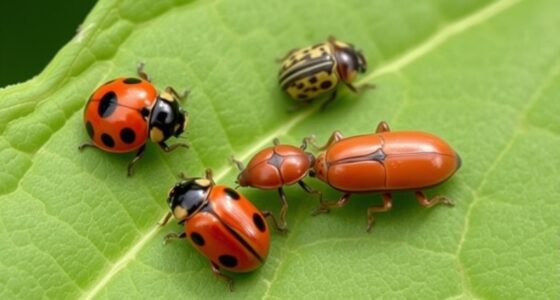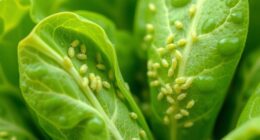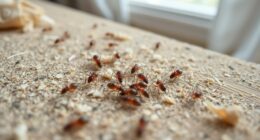To identify flea beetle shot-holes on brassicas, look for tiny, round punctures on leaves, especially on new growth, that appear suddenly. You’ll notice the small beetles jumping when disturbed and signs like stippling, stippled leaves, or frass near the holes. Damage often starts at leaf edges or near the midrib. Spotting these signs early helps you manage infestations effectively—if you keep exploring, you’ll discover more about their patterns and signs.
Key Takeaways
- Look for tiny, round, evenly spaced holes on young brassica leaves, especially on new growth.
- Observe for small, jumping beetles or signs of feeding activity on leaf undersides.
- Check for stippling or speckled appearance caused by flea beetle feeding on leaf surfaces.
- Identify damage patterns such as holes concentrated at leaf margins or near the midrib.
- Regularly scout plants during warm, dry weather to detect early signs of flea beetle activity.
Recognizing the Physical Signs of Flea Beetle Damage

Flea beetle damage is often easy to identify once you know what to look for. You’ll notice tiny, round holes or shot-holes on your brassica leaves, especially on young plants. These beetles have a quick lifecycle, so damage can appear suddenly. As they feed, their small, jumping movements make them hard to spot, but the damage is clear. Recognizing these physical signs early helps you implement plant resistance strategies effectively. You might see stippling or a speckled appearance on leaves, indicating feeding activity. Regular scouting is essential, especially during warm, dry conditions when flea beetles are most active. Understanding their lifecycle and physical damage signs, as well as the importance of high contrast ratio in visual detection, can help you better protect your crops from severe injury.
Differentiating Shot-Holes From Other Leaf Injuries

To tell shot-holes apart from other leaf injuries, look closely at the pattern of the holes. Flea beetle damage typically creates small, round, evenly spaced holes, while other injuries often have irregular shapes or patterns. Also, check for additional signs like frass or leaf stippling to confirm if flea beetles are responsible. Recognizing best identification methods can help differentiate between various types of leaf damage effectively.
Distinctive Hole Patterns
Understanding the distinctive hole patterns caused by flea beetle shot-holes can help you accurately identify their damage on brassica leaves. Flea beetle behavior results in tiny, round, or irregularly shaped holes that often appear in clusters. These holes typically have clean edges and are scattered across the leaf surface. Look for the following signs:
- Small, round punctures with a “shotgun” appearance
- Random distribution, often concentrated on the upper leaf surfaces
- Multiple holes close together, creating a stippled effect
- Absence of larger, irregular tears that indicate other pests or diseases
- Recognizing these patterns can also indicate the level of infestation, prompting timely management actions. Integrated pest management strategies can help reduce flea beetle populations effectively.
Additional Damage Indicators
While shot-holes caused by flea beetles have distinctive patterns, other leaf injuries can resemble them, making it essential to differentiate between them. Look for signs like frass or small, irregular feeding areas that don’t match typical flea beetle damage. Damage from diseases or mechanical injury often lacks the precise, round holes and may include discoloration or necrotic spots. Recognizing these indicators is crucial for effective pest management; misidentifying damage can lead to unnecessary insecticide use or missed infestations. Incorporating crop rotation to reduce pest populations and minimize other stress factors that cause leaf damage. Additionally, understanding the impact of automation in pest monitoring can improve early detection and targeted intervention. By observing additional damage indicators, you can better determine whether flea beetles are responsible or if other issues are harming your brassicas, ensuring targeted and sustainable control measures.
Typical Locations and Patterns of Damage on Brassica Leaves

You’ll notice flea beetle damage often starts in the central areas of the leaves, where the feeding creates small, round holes. Edges and margins are also common spots for shot-holes, especially along the leaf borders. Keep an eye out for irregularly shaped holes, which can indicate varying feeding patterns of the beetles. Recognizing patterns in angel numbers can help identify specific stages of infestation or plant stress related to pest activity.
Central Leaf Damage Patterns
Flea beetle damage on brassica leaves often appears as small, round shot holes concentrated in specific areas. You’ll notice these holes mainly in the central parts of the leaves, where flea beetles tend to feed after landing. Understanding flea beetle biology helps explain this pattern, as adults prefer feeding on the more tender, central leaf tissues. Recognizing these damage patterns early can improve pest management strategies. Look for:
- Dense clusters of tiny holes near the leaf center
- Uniform, circular holes with clean edges
- Damage spreading from the midrib outward
- Less damage along leaf margins
- The presence of headphones can help monitor pest activity during late evening or early morning when flea beetles are most active.
Edge and Margin Holes
In addition to central leaf damage, flea beetles often create distinctive holes along the edges and margins of brassica leaves. This pattern results from their behavior of feeding along the leaf’s perimeter, where their activity leaves a series of small, evenly spaced holes. These edge and margin holes are easily recognizable and can be an early sign of infestation. The damage tends to be concentrated at the leaf’s outer edges, especially in areas where the plant’s resilience is weaker or the leaves are more exposed. Flea beetles prefer feeding along these margins because they are accessible and less protected. Recognizing this typical damage pattern helps you identify flea beetle activity quickly and implement control measures before the damage affects the plant’s overall health and growth. Understanding insect behavior can further aid in targeted pest management strategies.
Irregular Hole Shapes
Irregular hole shapes on brassica leaves often indicate flea beetle feeding, as their bites are not uniform or symmetrical. You might notice the holes vary in size and shape, with some appearing jagged or uneven. Look for areas showing color variation, where the leaf tissue may turn yellow or brown around the damaged spots. Flea beetles tend to target the center of leaves or along leaf veins, sometimes causing leaf curling as a response to feeding damage. These irregular holes often cluster in specific regions, especially on younger, tender leaves. Keep an eye out for these distinctive patterns, as they can help you distinguish flea beetle damage from other pests. Recognizing these irregular holes is key to early detection and effective management. Additionally, leaf tissue response such as wilting or stippling can further indicate flea beetle activity on brassicas.
Seasonal and Environmental Factors Influencing Flea Beetle Activity

Seasonal and environmental factors play a crucial role in flea beetle activity on brassicas. Warmer temperatures and sunny conditions increase beetle activity and reproduction, making infestations more severe during spring and early summer. Cooler or cloudy weather can slow pest movement, reducing damage. Understanding pest life cycles helps you anticipate peak activity periods and plan timely interventions. Additionally, implementing crop rotation disrupts flea beetle populations by breaking their preferred habitat, lowering the risk of early-season infestations. Soil moisture levels also influence flea beetle behavior; dry conditions often lead to increased feeding as beetles seek moisture. Monitoring environmental cues such as temperature and humidity is essential for effective management, especially since precise weather patterns can significantly impact pest dynamics. By monitoring these environmental cues and adjusting your management strategies accordingly, you can better control flea beetles and protect your brassicas from shot-holes.
Visual Tips for Spotting Early Infestations

Early detection of flea beetle infestations starts with knowing what to look for on your brassicas. Pay close attention to tiny, round shot-holes on leaves, especially on new growth, as flea beetles tend to target tender tissue. Observe their behavior—flea beetles are quick jumpers, often moving rapidly across plant surfaces. Regularly inspecting your crops allows you to catch early signs before damage becomes severe. Implementing crop rotation strategies can help reduce flea beetle populations and make early spotting easier. Look for these visual cues:
- Small, round holes on leaves
- Frass or tiny black specks near holes
- Stunted or wilted seedlings
- Increased beetle activity on plant surfaces
Staying vigilant helps you identify early infestations, enabling timely control measures. Understanding pest behavior further improves early detection and management strategies.
Additional Signs of Flea Beetle Presence Beyond Shot-Holes

In addition to shot-holes, you can spot flea beetle presence through other telltale signs on your brassicas. One key sign is the presence of tiny beetles jumping when disturbed, especially near the plant’s base or on the undersides of leaves. Look for frass or small black droppings, which indicate feeding activity. The flea beetle life cycle involves larvae feeding underground, so healthy, vigorous plants may still show signs of adult activity. Also, consider their host plant preferences; they favor cruciferous crops like cabbage, broccoli, and kale. If you notice a pattern of damage across these plants, it’s a good sign of flea beetle presence. Recognizing these signs helps you act early before infestations cause severe damage.
Frequently Asked Questions
How Do Flea Beetles Affect Overall Brassica Crop Yields?
Flea beetle crop damage can considerably reduce your brassica yields by feeding on young plants and creating shot-hole damage. This pest activity hampers plant growth, weakens overall health, and can lead to substantial brassica yield loss if not managed early. You might notice stunted plants or uneven development, which directly impacts your harvest’s quality and quantity, making it essential to control flea beetles promptly to protect your crop’s productivity.
What Natural Predators Help Control Flea Beetle Populations?
You can naturally control flea beetle populations by encouraging beneficial insects, such as predator species like lady beetles, lacewings, and parasitic wasps. These beneficial insects prey on flea beetles, reducing their numbers and minimizing damage to your brassicas. To attract them, plant diverse flowers and avoid broad-spectrum insecticides. Supporting predator species creates a balanced ecosystem, helping keep flea beetle levels in check without relying on chemical controls.
Are Certain Brassica Varieties More Resistant to Flea Beetle Damage?
You can reduce flea beetle damage by choosing brassica varieties with strong varietal resistance. Cultivar selection plays a key role; some cultivars naturally resist beetle feeding better than others. When selecting your plants, look for those labeled as resistant or tolerant, as they’re more likely to withstand flea beetle attacks. By prioritizing resistant cultivars, you enhance your chances of a healthy, productive crop with fewer shot-holes caused by these pests.
How Can I Prevent Flea Beetles From Infesting My Brassica Seedlings?
Think of flea beetles as tiny thieves sneaking into your garden. To prevent infestations, you should practice companion planting with herbs like dill or marigolds, which repel pests. Also, rotate your crops each season to break the beetles’ lifecycle. These strategies create a protective barrier around your seedlings, making it harder for flea beetles to find a feast and ensuring your brassicas stay healthy and vibrant.
What Organic Methods Effectively Manage Flea Beetle Infestations?
To effectively manage flea beetle infestations organically, you should try companion planting with herbs like basil or nasturtiums, which repel beetles. Additionally, you can use organic insecticides such as neem oil or insecticidal soap, applied carefully to target the pests without harming beneficial insects. Combining these methods creates a natural barrier, reducing flea beetle damage and protecting your brassicas without synthetic chemicals.
Conclusion
Think of your brassicas as a fortress, with flea beetles as stealthy invaders leaving tiny, telltale holes like secret messages. By learning to spot these clues early, you’re like a vigilant guardian, catching the intruders before they breach the walls. Stay attentive to the patterns and signs, and you’ll keep your crops safe from this hidden threat. With a keen eye, you’ll turn the battle into a victory, ensuring healthy, thriving brassicas.
